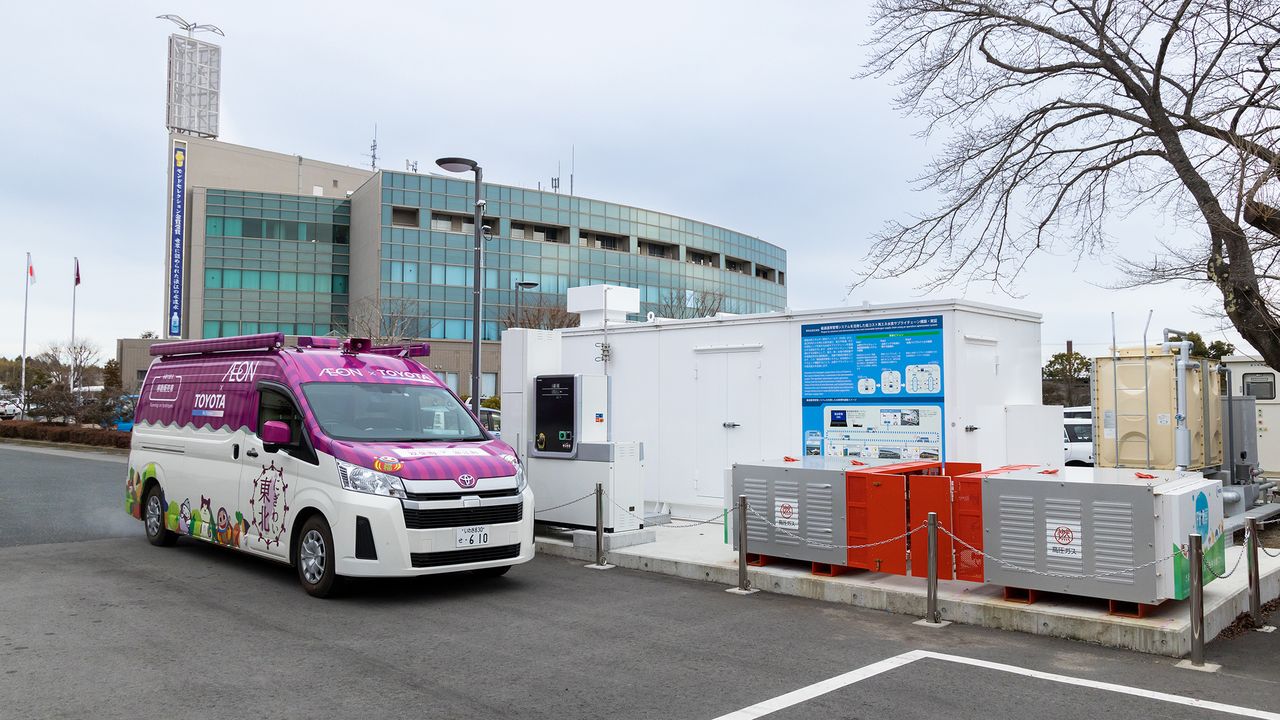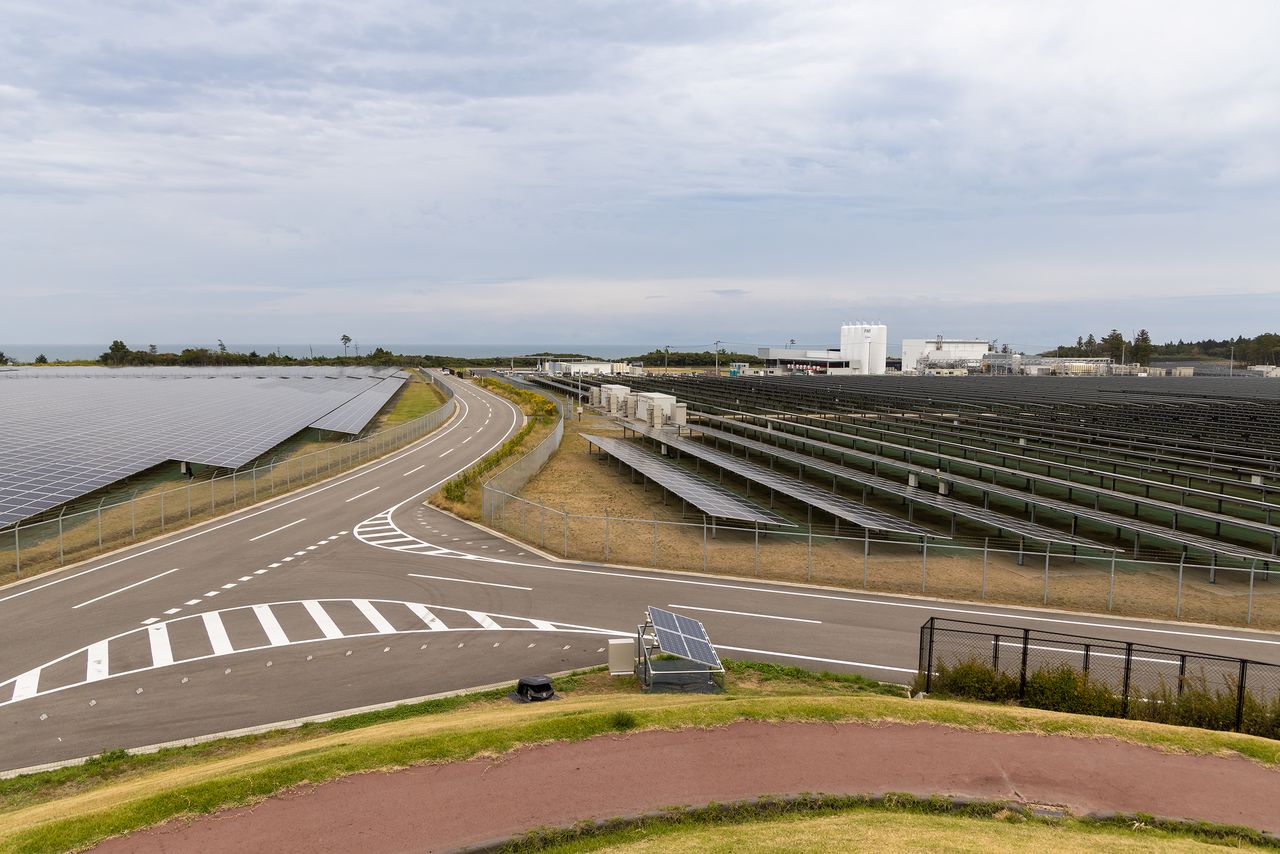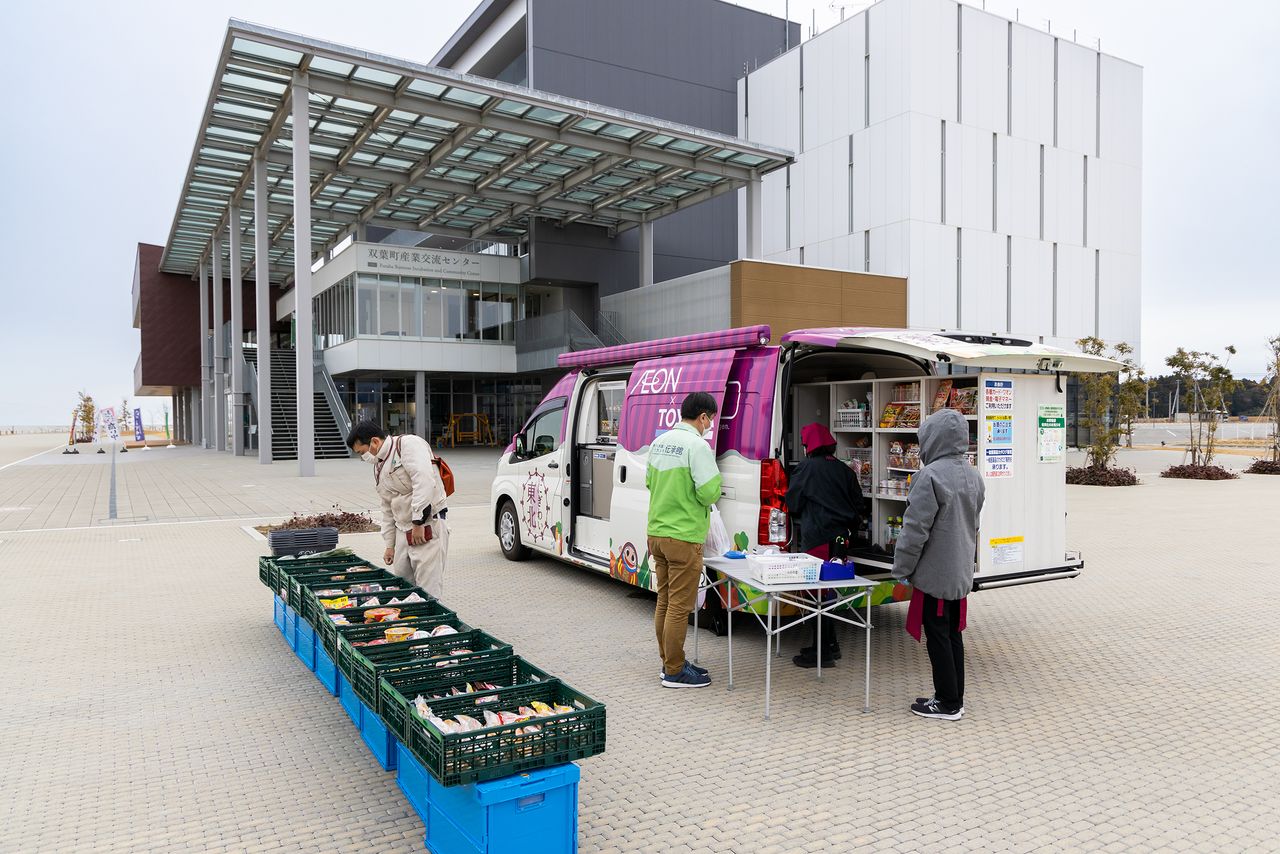
Spotlight on Hamadōri: the Fukushima Innovation Coast Framework
Green Hydrogen from Fukushima Fueling Zero-Carbon Initiatives
Technology Environment- English
- 日本語
- 简体字
- 繁體字
- Français
- Español
- العربية
- Русский
A Clever Way to Store Solar Energy
A sprawling solar array near Namie in Fukushima Prefecture is different from the large-scale solar farms that have become so common recently. Here at the Fukushima Hydrogen Energy Research Field, electricity generated by solar panels is used to produce hydrogen.

Solar panels cover the 180,000 square-meter site.

Giant hydrogen containment tanks tower over the solar farm.
In the wake of the meltdown at the Fukushima Daiichi Nuclear Power Station in 2011, the Japanese government made bolstering renewable energy output a priority, prompting the construction of a slew of large-scale solar and wind farms in Japan. Fukushima’s Hamadōri, the coastal area that was the epicenter of the nuclear disaster, drew a number of big projects launched through the Fukushima Innovation Coast Framework, a government initiative that aims to build new industrial infrastructure in the area.
While solar and wind offer bountiful carbon-free energy, their output varies according to factors like weather and time of day. While advances in power storage promise to help alleviate issues of intermittency, improving on the high-capacity batteries used in solar and wind farms present many hurdles, both in terms of cost and technology.
The Fukushima Hydrogen Energy Research Field offers a viable alternative to batteries for storing energy from renewable sources. The facility is home to a 20 megawatt solar farm that powers one of the world’s largest hydrogen plants, where hydrogen from water is extracted through the process of electrolysis. The hydrogen can then be used to generate electricity to power vehicles and for other purposes, with the only byproduct being water. Hydrogen produced in this manner, called “green hydrogen,” emits no carbon dioxide and has gained attention as a clean form of energy. Kept under pressure in tanks, hydrogen can be stored for extended periods and transported over long distances.

A display at the Fukushima facility shows different uses for hydrogen.

The hydrogen production unit produces and stores the element based on forecasted market demand.
The plant has the capacity to produce, store, and supply up to 1,200 normal cubic meters of hydrogen per hour, generating enough of the element in one day to supply 150 households with electricity for a month or fill the tanks of 560 fuel-cell electric vehicles (FCEVs). The hydrogen produced is stored temporarily in a gas holder before being purified, compressed, and transferred to hydrogen trailers for transport to Hamadōri and other parts of Fukushima.

Gas holders at the site store up to 150 cubic meters of hydrogen.

Each hydrogen trailer can carry 240 kilograms of hydrogen stored at 200 times atmospheric pressure.

The Olympic Torch Relay at Tokyo 2020 featured torches fueled by hydrogen from the plant.
Putting Namie on the Map
Championing the “hydrogen town” concept, Namie aims to make itself carbon neutral. In collaboration with the Fukushima Hydrogen Energy Research Field, Namie has boosted its hydrogen, including opening a small filling station at the town office for official vehicles and installing fuel cells for power generation at the roadside rest stop Michi no Eki Namie and the leisure facility Ikoi no Mura Namie.
Another hydrogen initiative that is garnering attention is a mobile supermarket serving the town and neighboring Futaba that is run by the Namie branch of supermarket chain Aeon. The small, colorfully painted FCEV bears the slogan “I run on hydrogen,” and advertises itself as a “supermarket on wheels.” The vehicle makes regularly stops at JR Futaba Station and the Great East Japan Earthquake and Nuclear Disaster Memorial Museum in Futaba.
Nitta Shin’ya, manager of the Aeon branch in Namie, says that locals and others are curious about the vehicle. “People come up to say that they saw it on the news, or to ask whether it’s really powered by hydrogen,” he explains. “It is helping build connections within the community.”

The mobile supermarket at the Futaba town office.

The brightly colored vehicle is easy to spot.
The evacuation order covering central Namie, where the town office is located, that had been in place was lifted on March 2017, allowing residents to return to their homes on a permanent basis. However, since then, the town’s population has only recovered to one-tenth of its pre-disaster size of 22,000.
Aeon Namie opened in July 2019 in response to a request from the local government. The only supermarket in the area, it serves both returning residents and new arrivals. Aeon’s hydrogen-powered mobile supermarket began operating in June 2022 as part of a joint initiative involving Aeon Tōhoku, the municipalities of Namie and Futaba, and major Japanese carmaker Toyota. An evacuation order that covered the entirety of Futaba was only lifted at the end of August 2022, and the area has yet to see shops return, which is a cause of concern for resident. The mobile supermarket aims to allay these worries while also using locally produced hydrogen to help create a sustainable community.
Nitta says that while Aeon Namie is a small supermarket, it tries to offer as comprehensive a range of products as possible to accommodate the wishes of the local community. “Shoppers requested that we carry fresh fish options, so we added another processing area,” he explains. He extols the mobile supermarket for enabling the outlet to serve a greater portion of the population. “Some parts of Namie are far from the store and many older people don’t have cars. The mobile supermarket has enabled us to deliver groceries to these customers.”

Aeon Namie is one of the few such shops serving the local community.

Nitta Shin’ya, manager of Aeon Namie.
Smiles Make it All Worthwhile
The mobile supermarket refuels at the hydrogen filling station at the town office. It takes around three minutes to fill the vehicles tanks, which can be done easily by a single staff member. The station is part of an experimental network that automatically projects demand and orders hydrogen deliveries from the nearby production plant at the optimum times and using the best route.

The mobile supermarket refueling at the Namie town office.

Refueling the hydrogen vehicle is similar to filling the tank of a gasoline-powered car.
The modified FCEV can carry up to 150 kilograms of stock and offers as many as 500 types of products, including chilled, frozen, and warmed goods. Along with food items like prepared lunches, fish, frozen entrees, and seasonings, customers can also find such daily necessities as plastic food wrap, detergent, toothbrushes, and facemasks.
Describing the vehicle as “quiet yet powerful,” Nitta says that he has driven the vehicle on the expressway as far as Kōriyama and found the ride to be very comfortable.

Hot drinks are among the many items on offer.

Items are unloaded and displayed from the rear of the vehicle.
The mobile supermarket is on the road five days a week and visits a total of 11 locations on different days. On the Friday that I visited, the first stop, at around 10:00 am, was the Futaba Business Incubation and Community Center. As soon as the wares were put on display, staff from the onsite restaurant came to top up on ingredients that were running low. They were joined by workers at reconstruction projects, staff from the neighboring museum, and others. Bentō boxes, bread rolls, and instant noodles were popular choices among the pre-lunch crowd.

The truck makes a stop at the Futaba Business Incubation and Community Center.

Customers often chat with staff while they shop.
At 11:30 am on weekdays, the mobile supermarket stops at the newly opened Futaba town office, which is situated at Futaba Station. The vehicle is not only quiet, but as it produces zero emissions, it can be parked by the building entrance without concern for exhaust fumes. Different displays are used at the location in line with the demand for lunches, snacks, and coffee. At 12:30, the vehicle returns to the supermarket to restock. In the afternoon it will visit the Tanashio business park and the Kiyohashi housing development.
Staff operating the truck say they vary offering based on where the next stop is and the time of day, being certain to also load any products requested the week before. ”Seeing our customers’ happy faces makes it all worthwhile.”

Sales staff display popular snacks and drinks.

Town office employees buy lunch at the mobile supermarket.
Hydrogen Society a New Pull for Namie
The Fukushima Hydrogen Energy Research Field and the mobile supermarket help highlight the potential of hydrogen as an energy source while also drawing attention to the challenges that need to be overcome in realizing its widespread use. Hydrogen filling stations are expensive to build, and Japanese law adds a second barrier by requiring that hydrogen stored under high-pressure (70 megapascals) at such facilities needs to be supervised by a qualified safety officer. This means that small stations like the one at the town office need to store the gas at half of the pressure of a larger site to avoid the costly regulation.
While setting up and operating hydrogen filling stations present challenges in terms of costs and staffing, the use of hydrogen is catching on. A new facility, the Namie Hydrogen Station, that opened in December 2022 is the first of its kind in the area. Nitta says that staff use the filling station at the town office on a daily basis and the Namie Hydrogen Station when the mobile supermarket needs to travel longer distances. “It’s now even more convenient.”

The recently opened Namie Hydrogen Station is supplied by the Fukushima Hydrogen Energy Research Field.
Nitta believes that to truly rebuild the area will require more than just putting things back the way they were before the disaster. “We also must create new things that boost the appeal of Namie and attract new residents,” he says. “I hope the use of hydrogen will increase and that it will become a selling point for the area.”
Asked if the arrival of more supermarkets and convenience stores would spell the end of the mobile supermarket, Nitta replied that Aeon Namie will continue to focus on catering to the needs of local customers. “I believe we’re helping the area to rebuild, but will need to change as well,” he explains. “There will still be plenty of need for the mobile supermarket, though. We will be doing more visits to elderly care facilities to make it easier for seniors to return to the area.”
Nitta says new stops are planned, such as one at a new housing development currently being built on the west side of Futaba Station.

With new municipal housing going up near Futaba station, demand for the mobile supermarket is unlikely to diminish anytime soon.
(Originally published in Japanese. Banner photo: The Aeon Namie mobile supermarket refuels at the Namie town office. All photos © Hashino Yukinori.)
Related Tags
Keisei Skyliner tourism disaster Fukushima Great East Japan Earthquake
